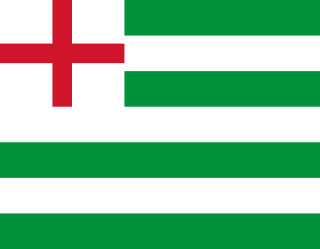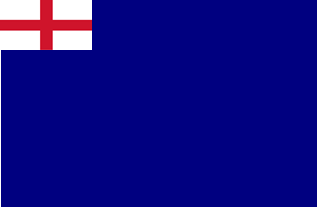Naval career
John Malyn began his career as a private ship owner and seaman when he was based in Calais, France in 1540. In October 1544 his ships and hoys were hired to assist in the transportation of troops returning from the Sieges of Boulogne (1544–46). [1] [3] In August 1554 he was appointed Captain of HMS Falcon a pinnace and assigned to patrolling duties off the East Anglian coast. [1] In September 1556 he was appointed under the command of Lord High Admiral of England Lord Effingham to escort Charles V, Holy Roman Emperor to Spain. [1]
From November 1558 to January 1559 he was appointed Vice-Admiral of the Narrow Seas and charged with protecting England's trade interests in the area. [1] [4] He took part in the Battle of Gravelines (1558) whilst commanding the Narrow Seas Squadron on approach to Calais he observed the French Army troop lines and maneuvered his ships close inshore, thus running the risk of beaching he then opened fire on them; his actions were personally noted in a letter from the Queen thanking him and granted him a pension. [5] Malyn was probably the only naval commander to achieve some level of significance during the Queen Mary's Anglo-French Wars of (1557–59) as part of the wider Italian War of (1551-1559). [6]
He commanded HMS Jennet during an expedition to Scotland from 1560 to early 1561. Towards the end of 1561 he was appointed Admiral of a squadron that was responsible for transporting military equipment to Ireland and additionally he was also Captain of HMS Willougby until 1562. [1] In December 1562 he was promoted to the post of Admiral of the Narrow Seas and captain of his flag ship the galleon HMS Grehound a 45-gun ship. The ship was on duties in the English Channel returning from France when it sank after hitting a sandbar off the coast of Rye, East Sussex on 5 April 1563, Malyn was lost at sea. [1] [7]

The Royal Scots Navy was the navy of the Kingdom of Scotland from its origins in the Middle Ages until its merger with the Kingdom of England's Royal Navy per the Acts of Union 1707. There are mentions in Medieval records of fleets commanded by Scottish kings in the twelfth and thirteenth centuries. King Robert I developed naval power to counter the English in the Wars of Independence (1296–1328). The build up of naval capacity continued after the establishment of Scottish independence. In the late fourteenth century, naval warfare with England was conducted largely by hired Scots, Flemish and French merchantmen and privateers. King James I took a greater interest in naval power, establishing a shipbuilding yard at Leith and probably creating the office of Lord High Admiral.

Admiral Sir William Wynter held the office of Surveyor and Rigger of the Navy for 40 years, from 1549 until his death in 1589, and combined that with the office of Master of Navy Ordnance from 1557. He was an admiral and principal officer of the Council of the Marine under Queen Elizabeth I of England and served the crown during the Anglo-Spanish War (1585–1604). He was returned four times to parliament in Elizabeth's time.

The Lieutenant of the Admiralty is a now honorary office generally held by a senior retired Royal Navy admiral. He is the official deputy to the Vice-Admiral of the United Kingdom. He is appointed by the Sovereign on the nomination of the First Sea Lord.

The Tudor navy was the navy of the Kingdom of England under the ruling Tudor dynasty (1485–1603). The period involved important and critical changes that led to the establishment of a permanent navy and laid the foundations for the future Royal Navy.

Grace Dieu was the flagship of King Henry V of England and one of the largest ships of her time. Launched in 1418, she sailed on only one voyage and was subsequently laid up at anchor in the River Hamble. She burned in 1439 after being struck by lightning. The wreck is a Protected Wreck managed by Historic England.
Mary Willoughby was a ship of the English Tudor navy. She appears in the navy lists from 1532 during the reign of Henry VIII. She was named after Maria Willoughby, a lady-in-waiting and close friend of Catherine of Aragon. The ship was taken by the Scots in 1536 and was included in the Royal Scots Navy, The English recaptured her in 1547. The ship was rebuilt in 1551, increasing in size from 140 bm to 160 bm.

HMS Actaeon was a 28-gun Coventry-class sixth-rate frigate of the Royal Navy. Her crewing complement was 200 and, when fully equipped, she was armed with 24 nine-pounder cannons, supported by four three-pounders and twelve 1⁄2-pounder swivel guns.
Lieutenant Admiral Sir William Woodhouse was an English naval commander and administrator who rose to the rank of Lieutenant of the Admiralty and was head of the Council of the Marine later called the Navy Board. He also served as a Member of Parliament of the Parliament of England from 1545 to 1564. He was prominent during an important time of the Navy Royal's development in the later half of the Tudor period.

The Admiralty and Marine Affairs Office (1546–1707), previously known as the Admiralty Office (1414–1546), was a government department of the Kingdom of England, responsible for the Royal Navy. First established in 1414 when the offices of the separate Admiral of the North and West were abolished and their functions unified under a single centralised command, it was headed by the Lord High Admiral of England. The department existed until 1707 when England and Scotland united to form the Kingdom of Great Britain, after which it was known as the British Admiralty.

The Admiral of the North also known as Admiral of the Northern Seas and Admiral of the Northern Fleet was a senior English Navy appointment. The Admiral was chiefly responsible for the command of the navy's fleet that operated in the North Sea and off the English coast out of Yarmouth from 1294 to 1412.

The Admiral of the South also known as Admiral of the Southern Fleet was a senior English Navy appointment. The post holder was chiefly responsible for the command of the navy's fleet that operated in the English Channel out of Portsmouth from 1294 to 1326.

The Admiral of the South, North and West formally known as Admiral of the Kings Southern, Northern and Western Fleets or Admiral of all the Fleets about England was a senior English Navy appointment and Commander-in-Chief of the English Navy from 1360 to 1369.

The Admiral of the Narrow Seas also known as the Admiral for the guard of the Narrow Seas was a senior Royal Navy appointment. The post holder was chiefly responsible for the command of the English navy's Narrow Seas Squadron also known as the Eastern Squadron that operated in the two seas which lay between England and Kingdom of France and England and the Spanish Netherlands later the Dutch Republic from 1412 to 1688. His subordinate units, establishments, and staff were sometimes informally known as the Command of the Narrow Seas.
Erith Dockyard located at Erith, Kent, England was an early Tudor naval dockyard operated by the English Navy that opened in 1512 due to persistent flooding the dockyard closed in 1521.

The Keeper of the Storehouses and formally known as the Keeper of the King's Storehouses was an English Navy appointment created in 1524 the office holder was a principal member of the Council of the Marine from 1546 until the post was abolished and his duties assumed by the Treasurer of the Navy in 1560. He was responsible for the storing and supply of naval stores at naval dockyards for the navy.

The Irish Squadron originally known as the Irish Fleet was a series of temporary naval formations assembled for specific military campaigns of the English Navy, the Navy Royal and later the Royal Navy from 1297 to 1731.

The North Sea Squadron was a temporary naval formation of the Tudor Navy Royal during the sixteenth century operating out of Newcastle, England.

The Channel Squadron also referred to as the Western Squadron (1512-1649) was a series of temporary naval formations first formed in under the English Tudor Navy Royal during the sixteenth century. Later during the Interregnum a channel squadron was formed as part of the Commonwealth Navy. During the 18th century as part of the Royal Navy.

The official history of the Royal Navy began with the establishment of the Navy Royal by Henry VIII in 1546. The modern incarnation of the institution re-emerged as the national naval force of the Kingdom of England in 1660, following the Restoration of King Charles II to the throne. However, for more than a thousand years before that there had been English naval forces varying in type and organisation. In 1707 it became the naval force of the Kingdom of Great Britain after the Union between England and Scotland which merged the English navy with the much smaller Royal Scots Navy, although the two had begun operating together from the time of the Union of the Crowns in 1603.

The English navy ship Greyhound, first built in 1544 or 1545, probably at Deptford, was wrecked in April 1563 on a sand bar near Rye. The Greyhound was a "galleass", smaller than the greatest warships of the English fleet.










